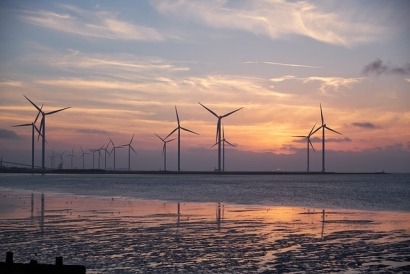
Below the Earth's surface lies heat that creates geothermal energy, which is a clean and renewable source. Utilizing the power produces little to no greenhouse gasses and requires little environmental impact to get started.
As of 2023, the United States is the largest producer of geothermal energy, with power plants in seven states. Indonesia is the second largest producer and both countries contributed to the 92 billion kilowatts of energy produced in 2019.
While it’s possible to use the energy in homes, it’s most often used in industrial environments to preserve food, pasteurize milk and mine gold. Geothermal heat pumps are also an excellent source for heating and cooling facilities.
The wind is an abundant resource worldwide and turbines can easily convert it into a green energy source. Wind farms utilize vertical and horizontal turbines, which catch the wind and use a generator to turn its power into electricity.
The United States alone produced nearly 140 gigawatts of electricity through wind power, capable of providing energy for more than 40 million homes and small businesses. As of 2022, there were around 70,800 turbines across the country, with wind power efforts now in 44 states, Guam and Puerto Rico.
The sun’s fire emits solar energy, which homes and businesses worldwide use to generate electricity. When the sun shines on the panels, the energy gets absorbed by photovoltaic cells that use it to create an electric current. A recent advancement in this energy is agrivoltaics, which came to light after a years-long research project by the University of Arizona.
It involves using drought-prone farmland to create solar energy hubs that can, in turn, shelter plants from harsh rays. Such fields are growing in the U.S. and other locations around the world. Solar-powered drip pumps are expanding the growth capabilities of farms in Africa.
Hydroelectric power is far from new. Thousands of years ago, Grecians used captured water to fuel their irrigation systems. Since the early twentieth century, concrete dams have produced enough energy for millions of homes nationwide.
While early hydroelectric power plants had some adverse effects, modern technologies allow people to generate power while preserving the ecosystems that share the water. The Archimedes hydrodynamic, Alden and Vortex turbines are current fish-friendly options for countries to capitalize on.
Research in 2022 found this energy is best during high-energy demand. Thanks to modern electronic converters, speed variation is now possible. The Department of Energy recently allotted $25 million for increased research and development of wave energy technology off the Oregon coast. This data should help develop further hydroelectric projects that can contribute to the Biden Administration’s goal for a net-zero electricity sector by 2035.
Using the four elements to create clean energy is essential to improving the state of the world. While already-established energy sources seem more convenient, they impact the planet in catastrophic ways.
Climate change is accelerating and the blame is on human contributions to carbon emissions. The ozone layer is supposed to protect Earth from dangerous levels of heat and radiation. However, human emissions contribute to the layer’s deterioration, allowing these hazards to travel through it. This change creates the greenhouse effect you probably learned about in school.
In the past few decades, the impact of human emissions reached an emergency level, as the rate of warming per decade doubled from where it was in the 1980s. Instead of rising around 0.14° Fahrenheit every ten years, it now rises about 0.32° F, creating a 2° F increase overall. That might not seem like much, but even small incremental changes can devastate ecosystems. The world is already seeing significant changes.
The planet is seeing more severe storms more often, which scientists say originated from human-produced climate change. These storms can devastate communities and make it harder for ecosystems to rebuild.
A warmer climate increases drought risk, making it harder for farmers to produce enough crops to feed an increasing global population.
Several communities rely on snow for clean water through a process called snowpack. However, less and faster-melting snow limits the ability to secure safe drinking water.
The Arctic is currently one of the fastest-changing areas due to climate change. With ice caps melting, the sea level is rising, threatening nearly half of the U.S. population living near or in coastal areas.
While some plant and animal species show signs of adaptation, many do not.
Polar bears, snow leopards, penguin species and sea turtles are just some animals that may go extinct without change.
You are also vulnerable to the impacts of climate change, even if you don’t realize it. Communities privileged to still have plenty of food and clean water are at a growing risk of heat-related illnesses, which can be deadly.
Rising temperatures and disappearing predators allow ticks and mosquitos to expand their reach, with some spreading devastating illnesses. With increasing floods, waterborne diseases are more likely to appear and spread. Humans must change their habits to support cleaner, more environmentally friendly lifestyles and protect the planet for future generations.
Earth’s essential elements and human innovation provide the potential for a world full of clean energy. By continuing to research and develop the power humans get from earth, wind, fire and water, they can create greener, more accessible energy across the globe.

